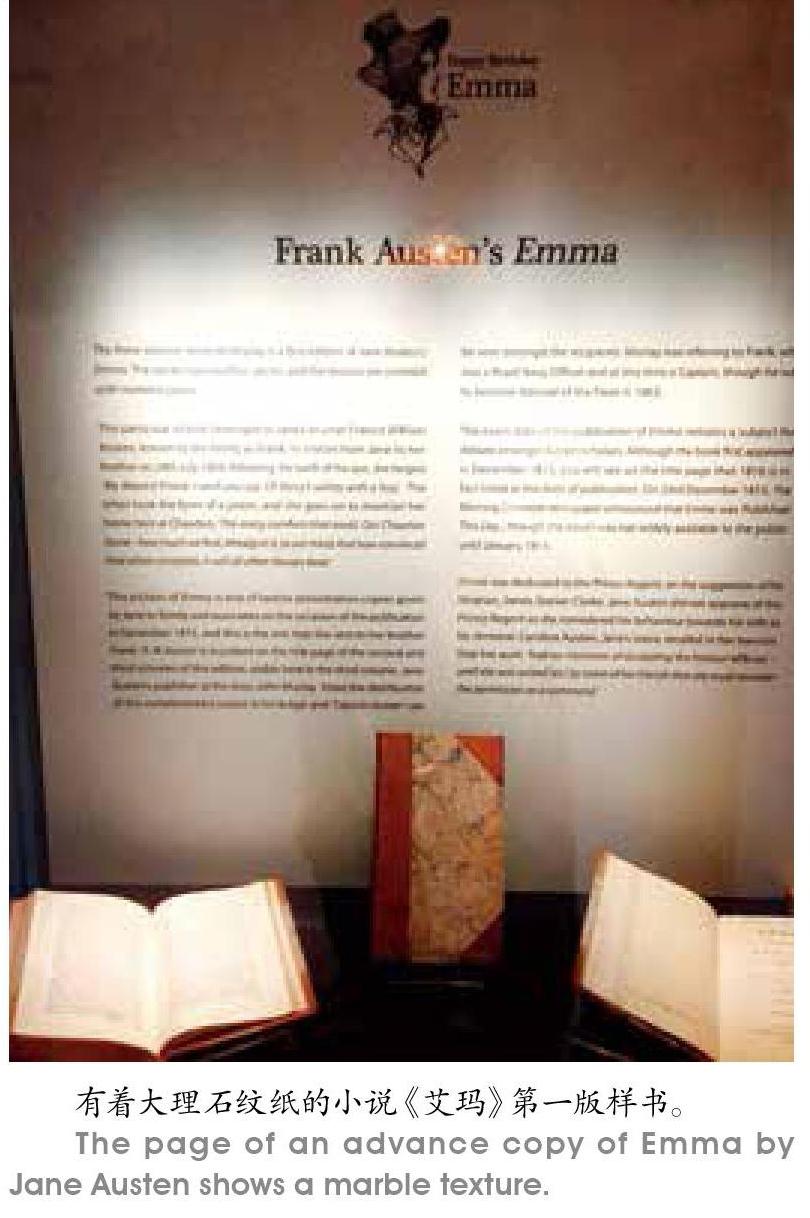寻找简·奥斯汀
2018-05-09米大友
米大友


在英国南部乡村伊斯特利小住数月,我经常去附近古城温切斯特转悠。温切斯特曾经是英格兰的首都,有着丰厚的历史文化遗产。英国女作家简·奥斯汀曾在这里生活多年,留下了许多供人缅怀的遗迹。
温切斯特访古寻幽
简·奥斯汀是18世纪至19世纪以来英国文坛的泰斗级女作家。她1775年出生于英国南部乡村小镇斯蒂文顿(Steventon),父亲是当地牧师,精通诗词,经常和简·奥斯汀一起赋诗谈史。简·奥斯汀因为天资聪慧,虽从小不曾上学接受正规教育,但在优良的家庭氛围熏陶下,养成了自学的习惯,喜欢读书的她,在十三四岁便开始写东西。简·奥斯汀一生与文字为伴,不曾成婚。她所擅长的细腻文笔、优美的情感描写,令无数坠入爱河的青年男女竞相效仿。她的作品在世界广为流传,令无数文字爱好者顶礼膜拜。她撰写的《傲慢与偏见》、《艾玛》等多部名著,频繁被改编成剧本,搬上银幕。
在温切斯特城南,我走过一段斑驳的中世纪古城墙,顺伊钦河清澈的水流往下游走,就在温切斯特学院附近,找到了简·奥斯汀生命最后时刻住过的房子。然而门上的牌子提示,这里是私人住宅,不对外开放。人们在这幢米黄色的房子对面,建了一个小小的纪念园地,墙面大理石碑上刻着简·奥斯汀的一句话“Know your own happiness, Call it hope”,这仿佛是她留给世人的警句。
简·奥斯汀埋葬于温切斯特大教堂。我在教堂入口附近的北面侧廊找到了她的安息地,金色的墓碑下,有人摆放着鲜花。
小村乔顿美丽奇妙
其实,我最想去找的,是位于温切斯特以东29公里处的小村乔顿(Chawton)。那里有简·奥斯汀的故居博物馆,她在那里住过8年。
按照旅游指南,我从温切斯特搭乘64路巴士前往乔顿。我上车买了当日来回票,并请司机到站时叫我一下。上了二层车厢,只有我和一位英国大叔。坐下后,我打开手机导航,找到乔顿村。导航的语音惊动了英国大叔,他问我去哪儿?我说乔顿。也许是我的发音不准,他问了好几遍才确认。然后,他从后排座位坐到我的身边对我说,去乔顿可能还要换另一路巴士吧?我吓了一跳!他叽里咕噜说着,我听不懂他的意思,也不知道该对他说什么。
大巴车穿过一座城镇,七拐八弯的。导航不断发出调整线路的提醒。我心里毛毛的。又上来一位英国大叔。前面的大叔坐过去向他咨询了一会儿,然后又坐回来跟我说话,大概是搞清了状况。
我说“我去找简·奥斯汀的房子”,并翻出手机里在温切斯特拍的奥斯汀临终前住过的房子的照片给他看。哦!他看来明白了,笑着点点头叽里呱啦又说了一通,像是在说:我知道那兒。我问大约还要多久才到?他说,10分钟左右!到了我会叫你。
车过一个大转盘时,他指着对面一个山坡:就是那儿!他用手比划着告诉我下车后怎么回头绕过转盘。我再三向他表示感谢并告别。车门开处,司机向我点点头,确认就在此站下。
车走了,四下无人。我背上双肩包用手机导航开始步行,绕过大转盘,穿越两条公路,走了约八九百米,终于看到了乔顿村口的牌子!
乔顿村是奥斯汀小说创作的灵感所在。据说,这里距简·奥斯汀的出生地仅10英里左右。从1809年至1817年,奥斯汀和她守寡的母亲、姐姐卡桑德拉(Cassandra)生活在这幢迷人的红砖房内。这幢两层楼建筑,房舍一面临路,三面花园环抱。房子主人是奥斯汀的三哥爱德华·奥斯汀(Edward Austen),乔顿村的大地主。他自己虽然没有在这里住过,但在奥斯汀一家搬来之前,他把住宅布置了一番,更新了水管,把前窗移到了侧面,既隔绝了外界干扰,又能使家人看见花园中的景色。简·奥斯汀对住宅非常满意,她在诗文中加以称赞:
我们的乔顿新家,多么令人赞叹!/那里有多美好啊!/还有如此的自信:等到新居万事完满,/定会让世上的宅院全都失色黯然。
奥斯汀一家在乔顿村生活得心满意足。姐姐和母亲主要负责料理家务和打理花园,雇来的男佣负责干重活,另外还雇有一位临时厨师。每天早晨大约9点,简·奥斯汀会在餐厅准备好早餐。她还弹得一手好钢琴,每天早晨在家人坐下来吃饭之前她都要练习钢琴。
有家人支持和帮助,简·奥斯汀可以自由地从事写作。她经常坐在餐厅里的那张小桌前,把它当作自己的写字台。在此居住期间,她的文学创作收获颇丰。就是在这里,靠着窗户,简·奥斯汀在长篇小说《理智与情感》和《傲慢与偏见》发表前进行了修改。房前离简·奥斯汀坐的地方几英尺之外,便是穿梭在伦敦、温切斯特、南安普敦和朴茨茅斯之间的马车驿道。在乔顿村居住期间,简·奥斯汀创作了被公认为其杰作的《曼斯菲尔德庄园》。后来又在此写成了《艾玛》。同是在乔顿村写成的《劝导》发表于简·奥斯汀去世之后。
阅读和散步在简·奥斯汀的生活中也占有重要位置。她把乔顿村称为“美丽奇妙的村庄”。她喜欢在乔顿村周围美丽的乡村地带寻幽览胜,一探究竟。有时她徒步前往附近的小镇阿尔顿,她和家人平时大多乘坐驴车去那里。
简迷们热情经久不衰
简·奥斯汀故居早在上世纪40年代就被改造成为一座博物馆。1984年至1994年,在著名简·奥斯汀研究学者指导下,乔顿村又对故居博物馆进行了改造。
現在的简·奥斯汀故居博物馆重现了乔治时代一个典型的殷实家庭的景象,拥有大片花园和宽敞明亮的房间,以及许多优雅的家具。展品中包括奥斯汀用于写作的小桌、有着大理石纹纸的小说《艾玛》第一版样书、奥斯汀与家人的通信手稿和为她姐姐精心刺绣的手绢。
踏着嘎吱嘎吱作响的楼板,参观者们小心翼翼地走动,细细体验两个世纪以前乡村贵族的生活氛围。视频室里播放着奥斯汀的故事,音量调得低低的。花园里是大片的草坪,周围点缀着低矮的灌木和各种盛开的鲜花,据说路旁的古栎树是奥斯汀当年亲手栽的。屋旁一棵硕大的欧洲红豆杉果实累累,深绿色的草坪上落红点点。游客们徜徉其间,沉浸在那早已消逝的简·奥斯汀的世界里,想象着这位文学大师外出散步或伏案写作时的情景。
走出奥斯汀的房子,我到乔顿村中走了一圈。整洁的小道,蜿蜒的溪流,高大乔木下平整的草地,用巨厚的植物秸秆铺设屋顶的农居和门前漂亮的花园等,都给我留下了深刻的印象。我回到简·奥斯汀故居博物馆对面的小咖啡馆喝了杯热咖啡暖暖身子,顺便给手机充电。我发现,尽管地处偏僻,但从停车场的车和咖啡馆的人流观察,到简·奥斯汀故居博物馆参观的人比我预想的要多得多。
“简迷”们的热情何以经久不衰?
也许我们可以从英国学者阿伯特(Rob Abbott)的《简·奥斯汀:将梦想嫁给文字》一书中找到答案。他在回答“为什么今天还要阅读简·奥斯汀”时说:因为现实意义而读,因为幽默而读,因为乐趣而读。他认为,简·奥斯汀是被誉为“地位可与莎士比亚平起平坐的作家”,所著的《傲慢与偏见》等6部小说,经过近两百年的检验,受到一代代读者的交口称赞,部部堪称上乘之作。她的作品如“两寸牙雕”,从一个小窗口中窥视到整个社会的形态和人情世故,在英国小说发展史上有承上启下的意义。
A leading figure in the British literary world of the 18th-19th century, Jane Austen (1775-1817) was born in Steventon, a small town in Hampshire, on 16 December 1775. For much of Janes life, her father served as the rector of the Anglican parishes at Steventon. Life in the Austen home was lived in “an open, amused, easy intellectual atmosphere”, which widened Janes youthful horizon and influenced her later life and works. She was a fast learner and extensive reader. At the age of 12, she tried her hand at dramatic writing; she wrote three short plays during her teenage years. Jane Austen never got married, immersing most of her life in the joy of reading and writing. Her use of biting irony, along with her realism and social commentary, has earned her acclaim among critics and scholars, and has enchanted numerous love-sick men and women.
Jane Austen has inspired a large number of critical essays and literary anthologies. Her novels have inspired many films, from 1940s to more recent productions like (1995) and (2016).
Austen died in a house in Winchester, where she was confined to bed and lived her last days, at the age of 41; and was buried in the north aisle of the nave of Winchester Cathedral. The epitaph composed by her brother James praises Austens personal qualities, expresses hope for her salvation and mentions the “extraordinary endowments of her mind”, but does not explicitly mention her achievements as a writer. The carvings on a marble wall in a memorial park across from the house reads: Know your own happiness. Call it hope.
The novelist spent eight years in Chawton, a lovely village about 29km from Winchester. Around early 1809 Austens brother Edward offered his widowed mother and sisters a more settled life – the use of a large cottage in Chawton that was part of Edwards nearby estate, Chawton House. Jane, Cassandra and their mother moved into the cottage with a charming brick fa?ade in the summer of 1809. Life was quieter in Chawton than it had been since the familys move to Bath in 1800. The Austens did not socialize with gentry and entertained only when family visited. Her niece Anna described the familys life in Chawton as “a very quiet life, according to our ideas, but they were great readers, and besides the housekeeping our aunts occupied themselves in working with the poor and in teaching some girl or boy to read or write.” The view in the sprawling garden inspired Jane Austen all the time. She loved the new residence so much that she wrote a poem for it. For her, the eight years in Chawton was content and perfect. Shed get the breakfast ready for everyone at around nine and play piano for her mother and sister before dinnertime. She spent most of her time writing in the dining room of this 17th century building. It was here that Janes genius flourished and where she wrote, revised and had published all her major works: , , , , , and , published posthumously in 1818.
Reading and strolling played an important role in the life of the writer. During her last eight years in her life, she explored the nook and cranny of Chawton which she called “a beautiful, marvelous village”. Sometimes shed walk all the way into the nearby small town.
The cottage is now Jane Austens House Museum, the only house where Jane lived and wrote that is open to the public. A double-decker bus took me to the village, where I felt closer to the writers soul.

The house was turned it into a museum dedicated to the life and works of Jane Austen, opening to the public in 1949. A Grade-I listed building and one of the most important literary sites in the world, the museum attracts tens of thousands of visitors each year. The Museum holds an important collection of objects associated with Jane Austen, including letters written by Jane and personal effects belonging to her and her family. Particular highlights include her jewelry, first editions of her books, furniture, textiles and the table at which she wrote her much loved novels.
Visitors can freely explore Janes home and beautiful cottage garden whilst learning about her life through exhibitions and displays. Hands-on activities for all ages can be found alongside in-depth information panels and family objects, housed in the rooms that Jane would have known. Then, once visitors have had their fill of the enchanting atmosphere, the Museum shop with a large selection of souvenirs is well worth a browse. A dedicated Learning Officer is ready to inspire and transport classes back to early 19th century Hampshire.
